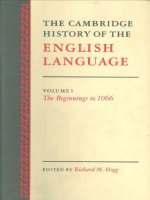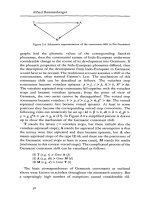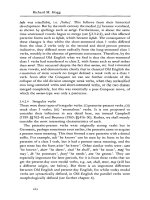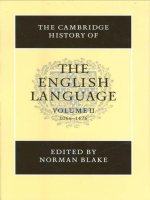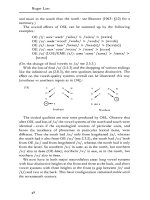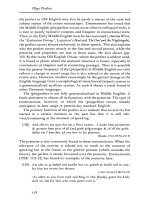The Cambridge History of the English Language Volume 5 Part 1 ppsx
Bạn đang xem bản rút gọn của tài liệu. Xem và tải ngay bản đầy đủ của tài liệu tại đây (817.44 KB, 65 trang )
f
i
The Cambridge History of
the
English Language is the first multi-volume
work to provide a full account of the history of English. Its authoritative
coverage extends from areas of central linguistic interest and concern to
more specialised topics such as personal names and place names. The
volumes dealing with earlier periods are chronologically based, whilst
those dealing with more recent periods are geographically based, thus
reflecting the spread of English over the last 300 years.
Volume V looks at the dialects of England since 1776, the historical
development of English in the former Celtic-speaking countries of
Scotland, Wales and Ireland, and at varieties of English in Australia,
New Zealand, South Africa, the Caribbean and South Asia. This unique
volume will be welcomed by all those interested in the spread of English
around the world.
THE CAMBRIDGE HISTORY
OF THE ENGLISH LANGUAGE
GENERAL
EDITOR Richard
M.
Hogg
voLUME
v English
in
Britain and
Overseas:
Origins and Development
HISTORY OF THE
ENGLISH LANGUAGE
VOLUME
v
English in Britain
and
Overseas:
Origins
and
Development
EDITED
BY
ROBERT BURCHFIELD
Emeritus Fellow
in
English Language and L.itentture,
St
Peter's
College,
University of Oxford
CAMBRIDGE
UNIVERSITY PRESS
Published by the Press Syndicate
of
the University
of
Cambridge
The Pitt Building, Trumpington Street, Cambridge
CB2
lRP
40
West 20th Street, New York, NY 10011-4211, USA
10
Stamford Road, Oakleigh, Melbourne 3166, Australia
© Cambridge University Press 1994
First published
1994
Printed in Great Britain at the University Press, Cambridge
A
catalogue
record
for
this
book
is
available
from
the
British Library
Library
of
Congress
cataloguing
in
publication
data
The Cambridge history
of
the English language.
Vol.
1
edited
by
Richard
M.
Hogg.
Vol. 2 edited by Norman Blake.
Vol. 5 edited by Robert Burchfield.
Includes bibliographical references and index.
Contents:
v.
1.
The beginning to
1066
-
v.
2.
1066-
1476
- v.
5.
English in Britain and Overseas:
origins and development.
1.
English language - History. I. Hogg, Richard
M.
II. Blake, N.
F.
(Norman Francis) III. Burchfield,
R.
W.
(Robert William)
PEI072.C361992 420'.9 91-13881
ISBN 0 52126474 X
(v.
1)
ISBN 0
521
264758 (v.
2)
ISBN 0
521
264782 (v.
5)
ISBN 0
521
264782 hardback
UP
CONTENTS
List
of
illustrations page
xi
List
of
tables
xii
List
of
contributors xiii
General Editor's preface
xv
Volume Editor's preface
xix
Acknowledgements
xx
List
of
abbreviations
xxi
1
INTRODUCTION
Robert Burchfield
1
1.1 Variety and diversity 1
1.2 A general survey of the varieties 4
1.3 Distinctive and shared features 8-
1.4 Some general verdicts, comments and predictions 13
1.5 Standard English: local or international
?
15
Further reading 18
PART I Regional varieties of English in Great Britain
and Ireland
2 ENGLISH IN SCOTLAND /.
Derrick McClure
23
2.1
2.2
2.3
2.4
3
3.1
3.2
3.3
Introduction
History of the speech community
History of the language
Language and culture in Scotland
Further reading
ENGLISH IN WALES Alan R.
Thomas
Introduction
Modernisation, industrialisation and education
Language and social function
23
24
46
89
92
94
94
100
103
Vll
Contents
3.4 Pembroke and The Gower 104
3.5 Attitudes to Welsh and English 105
3.6 Early Welsh English 107
3.7 Modern Welsh English 112
3.8 The future of Welsh English as a dialect 144
Further reading 147
4 ENGLISH IN IRELAND
Jeffrey
L.
Kallen
148
4.1 Introduction 148
4.2 External history 150
4.3 The linguistic history of English in Ireland 163
4.4 Related studies in Irish English 191
Further reading 195
Notes 196
5 THE DIALECTS OF ENGLAND SINCE 1776 Ossi
lhalainen 197
5.1 Some early observations 197
5.2 Early glossaries and collections of dialect words 200
5.3 Awareness of dialect areas from 1776 till the late
nineteenth century 205
5.4 Dialect markers in the late eighteenth and early
nineteenth century 213
5.5 Awareness of dialect as reflected by the number of
writings in and on English dialects up to 1877 231
5.6 Ellis' survey of English dialects (1889) 232
5.7 Wakelin on Ellis' divisions: the extent to which Ellis'
areas are still recoverable 247
5.8 Dialect areas today 247
Appendix 264
Further reading 269
Notes 270
PART II English overseas
6 ENGLISH IN AUSTRALIA
George
W. Turner 277
6.1 Introduction 277
6.2 Phonology 283
6.3 Morphology and syntax 301
6.4 Lexis: history 303
Further reading 327
via
7
7.1
7.2
7.3
8
8.1
8.2
8.3
8.4
8.5
8.6
8.7
8.8
8.9
9
9.1
9.2
9.3
9.4
9.5
9.6
9.7
9.8
10
10.1
10.2
10.3
10.4
10.5
10.6
10.7
10.8
10.9
10.10
10.11
Contents
ENGLISH IN THE CARIBBEAN
John
A. Holm
Introduction
The spread of English and Creole in the West Indies
The restructuring of English in the West Indies
Further reading
ENGLISH IN NEW ZEALAND
Laurie Bauer
Introduction
Pronunciation
The pronunciation of Maori
New Zealand English grammar
Vocabulary
Regional variation in New Zealand English
Maori English
North American influence
The origins of New Zealand English
Further reading
ENGLISH IN SOUTH AFRICA
William Branford
Introduction
The vocabulary: overview
The beloved country
Peoples and tongues
Other domains
Phonology
Syntax
Conclusions and prospects
Further reading
ENGLISH IN SOUTH ASIA
Braj
B.
Kachru
Introduction
English in the South Asian linguistic repertoire
Types of variation in South Asian English
The South Asianness of South Asian English
Models of English in South Asia
Bilinguals' creativity in South Asian English
Contact and impact: Englishisation
English in post-1947 language policies
Attitudes and schizophrenia about English
Current issues
Conclusion
Further reading
Notes
328
328
333
355
381
382
382
388
396
399
401
411
413
417
420
428
430
430
439
446
451
460
472
488
493
495
497
497
500
508
513
526
528
533
542
549
550
552
552
553
IX
Contents
Glossary
of
linguistic terms
554
Bibliography
568
Index
627
ILLUSTRATIONS
MAPS
4.1 Ireland
page
149
5.1 English dialect districts, 1887
236
5.2 Bundles of heterolexes in England
253
5.3 Trudgill's modern dialect areas
256
5.4 SED localities
265
7.1 Movements of English/Creole speakers in the
seventeenth century
336
7.2 Movements of English/Creole speakers after 1700
344
8.1 New Zealand
384
10.1 South Asia
498
FIGURES
5.1 Connections among dialects
211
5.2 Trudgill's classification of traditional dialects
254
5.3 Trudgill's classification of modern dialects
257
7.1 The convergence of English vowels in Creole English
365
XI
TABLES
3.1 Proportion of people speaking Welsh 1921-81
page
101
3.2 Proportion of people speaking Welsh 1921 -81
arranged by age group 102
3.3 Proportion of Welsh people speaking only English
1921-81 102
4.1 English population and percentages in towns, 1659 158
4.2 Percentages of Irish speakers in selected age cohorts 161
4.3 /a/variation in a Belfast speaker 189
4.4 Realisation of/k, g/before/ar/in Armagh 191
5.1 Criteria used to define English dialect areas 249
5.2 The pronunciation of Trudgill's eight diagnostic features 255
7.1 Palatalised consonants 369
7.2 Tense and aspect markers in various Creole and African
languages 374
9.1 Languages of origin by period 444
~10.1 The main languages of South Asia 499
10.2 Indian faculty preference for models of English for
instruction 527
10.3 Indian graduate students' attitude towards various
models of English 527
10.4 Indian graduate students' self-labelling of
the
variety of
their English 527
xn
CONTRIBUTORS
LAURIE BAUER Reader in Linguistics, Victoria
University
of
Wellington
WILLIAM BRANFORD Emeritus
Professor
of Linguistics and English
Language, Rhodes University
ROBERT BURCHFIELD Emeritus Fellow in English
Language
and
Literature,
St
Peter's
College,
University
of Oxford
JOHN
A
HOLM
Professor
of English and Linguistics, Hunter
College
and
the Graduate Center of the City
University
of New York
fOSSI IHALAINEN
Professor
of English
Philology,
University
of Helsinki
BRAJ B. KACHRU Center for Advanced Study
Professor
of Linguistics,
and
Jubilee Professor
of Liberal Arts and
Sciences,
University
of Illinois at
Urbana—Champaign,
Urbana
JEFFREY L. KALLEN Senior Lecturer in Linguistics and
Phonetics,
Trinity
College
Dublin
J. DERRICK McCLURE
Senior
Lecturer, Department of English,
University of Aberdeen
ALAN
R
THOMAS
Research Professor
in Linguistics,
University
of
Wales,
Bangor
GEORGE W. TURNER Honorary
Research
Associate, English
Department, University of Adelaide
This volume is dedicated to the memory
of
Professor Ossi Ihalainen, who died on 15 September
1993 from injuries sustained in
a
road accident in Finland. At the time of his death his chapter had
been completed and the volume was on the point of going to press.
Xlll
Although it is a topic of continuing debate, there can be little doubt that
English
is the
most widely spoken language
in the
world, with
significant numbers
of
native speakers
in
almost every major region
-
only South America falling largely outside the net. In such a situation an
understanding of the nature of English can be claimed unambiguously
to be of world-wide importance.
Growing consciousness
of
such
a
role
for
English
is one of the
motivations behind this History. There
are
other motivations
too.
Specialist students have many major and detailed works
of
scholarship
to which they can refer, for example Bruce Mitchell's Old
English
Syntax,
or, from
an
earlier age, Karl Luick's Historische Grammatik der
englischen
Sprache.
Similarly, those who come new
to
the subject have both one-
volume histories such
as
Barbara Strang's History
of
English
and
introductory textbooks
to a
single period,
for
example Bruce Mitchell
and Fred Robinson's A.
Guide
to
Old
English.
But what is lacking is the
intermediate work which can provide a solid discussion of the full range
of the history of English both to the Anglicist who does not specialise in
the particular area
to
hand
and to the
general linguist who
has no
specialised knowledge of the history of English. This work attempts
to
remedy that lack. We hope that
it
will be of use to others too, whether
they are interested in the history of English for its own sake, or for some
specific purpose such as local history or the effects of colonisation.
Under
the
influence
of
the Swiss linguist, Ferdinand
de
Saussure,
there has been, during this century,
a
persistent tendency
to
view
the
study of language as having two discrete parts: (i) synchronic, where a
language is studied from the point of view of one moment in time; (ii)
diachronic, where a language is studied from a historical perspective.
It
might therefore be supposed that this present work is purely diachronic.
xv
General Editor's preface
But this is not so. One crucial principle which guides The
Cambridge
History of the English
Language
is that synchrony and diachrony are
intertwined, and that a satisfactory understanding of English (or any
other language) cannot be achieved on the basis of one of these alone.
Consider, for example, the (synchronic) fact that English, when
compared with other languages, has some rather infrequent or unusual
characteristics. Thus, in the area of vocabulary, English has an
exceptionally high number of words borrowed from other languages
(French, the Scandinavian languages, American Indian languages,
Italian, the languages of northern India and so on); in syntax a common
construction is the use of
do
in forming questions (e.g.
Do
you like
cheese?),
a type of construction not often found in other languages; in
morphology English has relatively few inflexions, at least compared
with the majority of other European languages; in phonology the
number of diphthongs as against the number of vowels in English
English is notably high. In other words, synchronically, English can be
seen to be in some respects rather unusual. But in order to understand
such facts we need to look at the history of
the
language; it is often only
there that an explanation can be found. And that is what this work
attempts to do.
This raises another issue. A quasi-Darwinian approach to English
might attempt to account for its widespread use by claiming that
somehow English is more suited, better adapted, to use as an
international language than others. But that is nonsense. English is no
more fit than, say, Spanish or Chinese. The reasons for the spread of
English are political, cultural and economic rather than linguistic. So
too are the reasons for such linguistic elements within English as the
high number of borrowed words. This History, therefore, is based as
much upon political, cultural and economic factors as linguistic ones,
and it will be noted that the major historical divisions between volumes
are based upon the former type of events (the Norman Conquest, the
spread of printing, the declaration of independence by the USA), rather
than the latter type.
As a rough generalisation, one can say that up to about the
seventeenth century the development of English tended to be cen-
tripetal, whereas since then the development has tended to be
centrifugal. The settlement by the Anglo-Saxons resulted in a spread of
dialect variation over the country, but by the tenth century a variety of
forces were combining to promote the emergence of
a
standard form of
the language. Such an evolution was disrupted by the Norman
xvi
General Editor's preface
Conquest, but with the development of printing together with other
more centralising tendencies, the emergence of
a
standard form became
once more, from the fifteenth century on, a major characteristic of the
language. But processes of emigration and colonisation then gave rise to
new regional varieties overseas, many of which have now achieved a
high degree of linguistic independence, and one of which, namely
American English, may even have a dominating influence on British
English. The structure of this work is designed to reflect these different
types of development. Whilst the first four volumes offer a reasonably
straightforward chronological account, the later volumes are geo-
graphically based. This arrangement, we hope, allows scope for the
proper treatment of diverse types of evolution and development. Even
within the chronologically oriented volumes there are variations of
structure, which are designed to reflect the changing relative importance
of various linguistic features. Although all the chronological volumes
have substantial chapters devoted to the central topics of semantics and
vocabulary, syntax, and phonology and morphology, for other topics
the space allotted in a particular volume is one which is appropriate to
the importance of that topic during the relevant period, rather than
some pre-defined calculation of relative importance. And within the
geographically based volumes all these topics are potentially included
within each geographical section, even if sometimes in
a
less formal way.
Such a flexible and changing structure seems essential for any full
treatment of the history of English.
One question that came up as this project began was the extent to
which it might be possible or desirable to work within a single
theoretical linguistic framework. It could well be argued that only a
consensus within the linguistic community about preferred linguistic
theories would enable a work such as this to be written. Certainly, it was
immediately obvious when work for this History began, that it would be
impossible to lay down a 'party line' on linguistic theory, and indeed,
that such an approach would be undesirably restrictive. The solution
reached was, I believe, more fruitful. Contributors have been chosen
purely on the grounds of expertise and knowledge, and have been
encouraged to write their contributions in the way they see most fitting,
whilst at the same time taking full account of developments in linguistic
theory. This has, of course, led to problems, notably with contrasting
views of the same topic (and also because of the need to distinguish the
ephemeral flight of theoretical fancy from genuine new insights into
linguistic theory), but even in a work which is concerned to provide a
xvn
General Editor's preface
unified approach (so that, for example, in most cases every contributor
to a volume has read all the other contributions to that volume), such
contrasts, and even contradictions, are stimulating and fruitful. Whilst
this work aims to be authoritative, it is not prescriptive, and the final
goal must be to stimulate interest in a subject in which much work
remains to be done, both theoretically and empirically.
The task of editing this History has been, and still remains, a long and
complex one. As General Editor I owe a great debt to many friends and
colleagues who have devoted much time and thought to how best this
work might be approached and completed. Firstly, I should thank my
fellow-editors: John Algeo, Norman Blake, Bob Burchfield, Roger Lass
and Suzanne Romaine. They have been concerned as much with the
History as a whole as with their individual volumes. Secondly, there are
those fellow linguists, some contributors, some not, who have so
generously given of their time and made many valuable suggestions:
John Anderson, Cecily Clark, Frans van Coetsem, Fran Colman, David
Denison, Ed Finegan, Olga Fischer, Jacek Fisiak, Malcolm Godden,
Angus Mclntosh, Lesley Milroy, Donka Minkova, Matti Rissanen,
Michael Samuels, Bob Stockwell, Tom Toon, Elizabeth Traugott, Peter
Trudgill, Nigel Vincent, Anthony Warner, Simone
Wyss.
One occasion
stands out especially: the organisers of the Fourth International
Conference on English Historical Linguistics, held at Amsterdam in
1985,
kindly allowed us to hold a seminar on the project as it was just
beginning. For their generosity, which allowed us to hear a great many
views and exchange opinions with colleagues one rarely meets face-to-
face,
I must thank Roger Eaton, Olga Fischer, Willem Koopman and
Frederike van der Leek.
With a work so complex as this, an editor is faced with a wide variety
of problems and difficulties. It has been, therefore, a continual comfort
and solace to know that Penny Carter of Cambridge University Press has
always been there to provide advice and solutions on every occasion.
Without her knowledge and experience, encouragement and good
humour, this work would have been both poorer and later. After the
work for Volume I was virtually complete, Marion Smith took over as
publishing editor, and I am grateful to her too, not merely for ensuring
such a smooth change-over, but for her bravery when faced with the
mountain of paper from which this series has emerged.
Richard M. Hogg
xvin
VOLUME EDITOR'S PREFACE
As was
to be
expected,
a
volume
of
this complexity has taken
a
long
while
to
prepare. The procedures followed were the same as those that
worked well in other volumes. As the first drafts of chapters arrived they
were circulated for comment to the volume editors and to the writers of
other chapters in this volume. The results, though time-consuming and
sometimes challenging, were always beneficial,
and I
would like
to
record my thanks to all those who helped in this way.
It should
be
emphasised that contributors
to
this volume were
not
required
to
follow strict guidelines
in
the way
in
which they presented
their findings. Any such attempt would have been doomed
to
failure,
since the subject matter is so diverse and the scholarly evidence available
in each area so markedly unequal.
It comes
as no
surprise that one work above
all
was found
by the
contributors
to
be a central point of comparison and a landmark for all
future scholarly research into
the
pronunciation
of
present-day
varieties of English: this seminal work is
J.
C. Wells'
Accents
of English
(Cambridge University Press, 3 vols., 1982).
For their invaluable comments on the glossary of linguistic terms I am
grateful
to
John Algeo, Laurie Bauer, John Holm, Jeffrey Kallen and
Derrick McClure. Some other scholars gave welcome advice
on
particular entries.
I should also like
to
place
on
record
my
special thanks
to two
Cambridge University Press editors: to Penny Carter, who drew me into
the project and governed
its
fortunes with exemplary enthusiasm and
efficiency until she moved
to
another department
in
the Press; and
to
Judith Ay ling, who gave me excellent advice
and
unfailing guidance
during
the
later stages
of
the editorial process.
I am
also indebted
to
Jenny Potts, who brought her considerable copy-editing skills to bear on
the complex typescripts of
the
contributors to this volume.
Robert Burchfield
xix
ACKNOWLEDGEMENTS
The contributors to this volume are grateful for the help and advice they have
received from friends and colleagues, as well as from their fellow contributors
and the editors
of
and contributors
to
other volumes. We wish especially
to
thank the following:
Winifred Bauer, Ciaran Brady, Jean Branford, David Gough, John Harris, Niel
Hauptfleisch, Janet Holmes, Jonathan Hope, Daniel Huws, M. A. James,
Yamuna Kachru, Juhani Klemola, Merja Kyto,
L.
W. Lanham, Roger Lass,
William Liston, Daryl McLean, Margaret Mannion, Jim Milroy, Lesley Milroy,
Michael Montgomery, Cecil L. Nelson, Harry Orsman, Elizabeth Pearce,
Michael Pye, Tomos Roberts, Graham Shorrocks, Penny Silva, Peter Trudgill,
Wolfgang Viereck.
The index
was
compiled
by
Fiona Barr. Juhani Klemola, University
of
Joensuu, deserves special mention for his reading of the proofs of chapter
5
after
the death of Ossi Ihalainen.
xx
ABBREVIATIONS
AES
Afrik.
AL
AmerE
AND
AUMLA
AustE
aux
C
CCDE
CE
CV
DOST
DSAE.Hist.
Du.
EDD
EDG
EDS
EFL
ESc.
ESL
GenAm.
Atlas
ofEnglish Sounds
(ed.
E.
KoVoetal.
Berne: Francke,
1979)
Afrikaans
Aitken's Law
American English
Australian National Dictionary
(see p.
327)
Journal
of the
Australasian
Universities Language
and
Literature Association
Australian English
auxiliary
consonant
Corpus
of
Contemporary Dialects
of
England
(see p. 589)
Creole English
consonant followed
by
vowel
Dictionary
of
the Older Scottish Tongue
(see p.
92)
Dictionary
of
South
African
English on Historical Principles
(In preparation. See pp. 443; 616: Silva 1990)
Dutch
English Dialect Dictionary
(ed. J.
Wright, London:
Oxford University
Press.
6
vols.
1898-1905)
English Dialect Grammar
English Dialect Society
English as
a
foreign language
Early Scots
English as
a
second language
General American
XXI
List
GIE
GVS
HRT
IE
Ir.
Kh.
LAE
LAS
LI
L2
MCC
ME
ModE
ModSc.
MSc.
Ng.
NLW
NZE
OE
OED
ON
OSc.
P
PDE
RP
SAE
SAEP
SAfrDu.
SAfrE
SED
SND
So.
SSE
of abbreviations
General Indian English
Great Vowel Shift
high rising tone
Indian English
Irish
Khoisan
Linguistic
Atlas of
England
(ed.
H. Orton
et
al.
London
Croom Helm, 1978)
Linguistic
Atlas of
Scotland
(see p. 92)
first language
second language
Miskito Coast Creole
Middle English
Modern English
Modern Scots
Middle Scots
Nguni
National Library of Wales
New Zealand English
Old English
Oxford English Dictionary
Old Norse
Older Scots
Portuguese
Present-Day English
Received Pronunciation
South Asian English
South African English Pronunciation
South African Dutch
South African English
Survey
of
English Dialects
(ed. H. Orton et al. Leeds
Arnold, 1962-71)
Scottish National Dictionary
(see p. 92)
Sotho
Scottish standard English
XXll
List of abbreviations
ST
StE
SVO
TMA
Ts.
VP
VSO
WE
Xh.
Zu.
Sotho-Tswana
standard English
subject + verb + object
tense, modality and aspect
Tswana
verb phrase
verb + subject
4-
object
Welsh English
Xhosa
Zulu
XXlll

